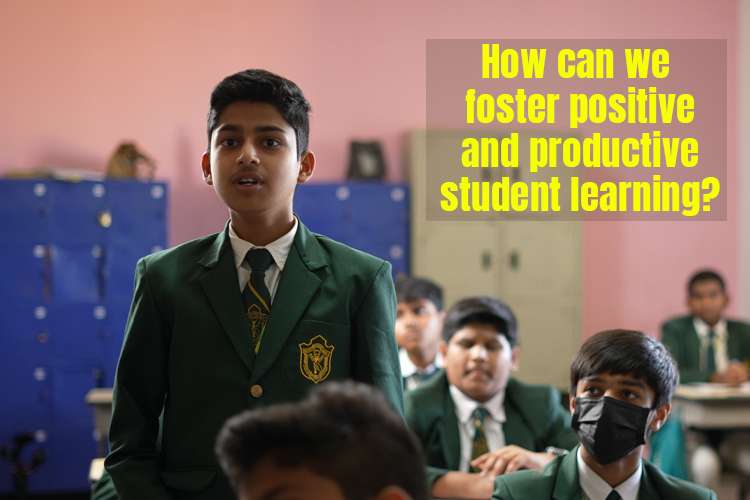Education is not just about books and classrooms. It’s a journey that takes place in a thoughtfully nurtured environment, where students can learn, evolve, and thrive. In this article, we’ll explore the magic of crafting positive and productive learning spaces at DPS Warangal. We’ll talk about things like behavior, the vibe, visuals, respect, health, culture, and more. These are the ingredients that make a studying world more than just walls and ceilings. So, come along as we uncover what makes these study spaces truly special.
1. Establishing positive behavior & expectations
Creating a positive classroom environment is like planting the seeds for student success. It’s all about having clear rules and promoting a culture of respect and responsibility among everyone. When we do this it’s easy for students to understand what’s expected of them in terms of their behavior and how they perform in class. This helps keep things focused and friendly.
But it’s not just about rules. It’s also about encouraging good manners, communication, and empathy among kids. By doing this, we’re not just making the classroom experience better. we’re giving children skills they’ll use in their lives outside of school. So, it’s really about setting the stage for a great educational environment where students feel at home, respected, and super motivated to do their best.
2. Creating a welcoming atmosphere
When students walk into a classroom, they should feel like they’re entering a space that’s comfortable, welcoming, and exciting. To make this happen, teachers and school administrators need to focus on both the physical and emotional aspects of the environment.
Physically, a welcoming atmosphere means having a classroom or education area that’s neat, well-organised, and visually pleasing. Think comfy seats, good lighting, and a tidy layout. An organised and inviting space helps kids to relax and be more open to learning. And let’s not forget about the temperature and fresh air – a cozy climate contributes to an overall sense of well-being.
Emotionally, creating a welcoming atmosphere involves greeting children with warmth and a friendly attitude. A simple smile, a kind word, or a personal hello can go a long way in making kids feel valued and appreciated. Encourage open communication, show empathy, and be responsive to children’s needs – these are all essential for an emotionally welcoming environment. When students feel emotionally safe and cared for, they’re more likely to actively engage in their studies and participate in class activities, resulting in a more positive and productive learning experience.
3. Displaying inspiring images & text
Have you ever noticed how inspiring images and text can make a learning space come alive? They have the power to spark curiosity, creativity, and excitement in students. Imagine walking into a classroom or study area that’s decorated with cool quotes, motivational posters, and eye-catching art. It’s like an instant connection for children, making them feel engaged in their educational journey.
These images and words are like a daily dose of inspiration, reminding kids about all the exciting possibilities that education holds. They’re like a gentle nudge to dream big, put in the hard work, and keep going when things get tough. But it’s not just about the good vibes. These visuals can also show real-life examples and new perspectives getting those brain gears turning. The result? A study space where students can’t wait to explore new ideas, learn, and be their very best.
4. Instilling a sense of belonging & respect
When students feel like they belong, it means they are valued, accepted, and part of the classroom community. This is super important for their emotional well-being, self-esteem, and motivation to learn. It creates a safe space where kids can express themselves, share their thoughts, and collaborate with their peers. When children feel respected by both their peers and educators, it boosts their self-worth and trust, making it easier for them to communicate openly and engage in study without fear of judgment or discrimination.
So, how can we make this happen? Well, educators and administrators can promote inclusivity, encourage collaboration, and address bullying or discrimination promptly. They can also create an environment where every student’s background and perspectives are acknowledged and respected. By focusing on these aspects, educators can build a classroom where kids feel like they are a vital part of the educational community. This fosters a stronger connection and a better environment for academic and personal growth.
5. Incorporating music & the arts
Music and art can make learning fun and exciting! When kids groove to music or express themselves through art, it’s like opening a window to fresh air in the usual classroom routine. They can make music, play instruments, and sing together, all while working as a team and getting smarter.
Drawing, acting, and dancing are cool ways for students to share their thoughts and feelings, boosting their confidence and communication skills. Painting, acting out stories, or putting on a dance show can make education more fun. It’s also a chance for them to explore different cultures and ideas, broadening their horizons. So, when we mix in music and the arts, it’s like sprinkling a little extra magic into the educational journey, making it a lot more colorful and enjoyable.
6. Leveraging technology to enhance education
In today’s world, technology is everywhere, and education is no exception. It’s all about using digital tools to make learning more exciting, interactive, and efficient. When technology is used in the classroom, It comes with a bunch of really good things. interactive software, online platforms, and multimedia content, all customised to suit different learning styles and needs.
One of the coolest things about technology in teaching is how it tailors the educational journey. Adaptive study platforms let students set their own pace, dishing out content and help tailored to what they’re good at and where they need a boost. Plus, there’s the fun factor – tech can turn studying into a game or take students on a virtual adventure in a lab or simulation. It’s like an exciting learning celebration that not only catches their interest but also improves their memory. So, in short, using technology in education is all about riding the wave of innovation to create engaging, efficient, and super-personalised learning adventures that set students up for success in the digital age.
7. Prioritising student health and wellness
When we talk about student health and wellness, we’re not just talking about physical health. We’re also talking about mental and emotional well-being. It’s important to prioritise all three aspects of health to create a positive and productive learning environment. Think about it, when kids feel good, they are more likely to be engaged in their studies, perform well academically, and contribute positively to the classroom’s atmosphere. That’s why we believe that prioritising student health and wellness is so important.
So, what does this look like in practice? It means providing good food, encouraging physical activity, and offering support for mental health. A balanced diet and opportunities to be active aren’t just good for the body, they boost cognitive function too. And when we address mental health and help kids manage stress, they’re better equipped to handle academic challenges and peer relationships. When children feel genuinely cared for and supported in their overall well-being, they’re in a better position to shine academically and in life. And that’s what we want for all students – to thrive and succeed in school and beyond!
8. Establishing a positive learning culture
Creating a positive learning culture is like setting the stage for a great show. It’s not just about lessons, it’s about making a space where everyone’s part of the plot, where curiosity is the star, and where making mistakes is just a plot twist, not the end.
Imagine a place where folks talk openly, trust each other, and feel like a team. Here, it’s all about thinking, creativity, and finding solutions, where asking questions is cool and exploring what kids love is the norm. And you know what? It’s like believing kids can learn and grow just by giving it their best shot.
A positive study culture is about making a space where learning feels like an adventure, where kids are in the driver’s seat, and where they’re building the skills to ace not just school but life’s big stage.
Teaching isn’t just about books and classrooms. It’s about the atmosphere that wraps around it all. When we engage with the ideas we’ve explored here teachers, parents, and school leaders can create a space that’s alive with energy and positivity. It’s a place where everyone feels valued, where creativity and tech play a role, and where we care about the whole person, not just the student. This kind of environment isn’t just for studying facts and figures, it’s a stage for life’s big show. It’s where students get the boost they need to succeed in school and beyond. So, by nurturing these spaces, we’re giving kids a launchpad into a future full of promise and potential.




